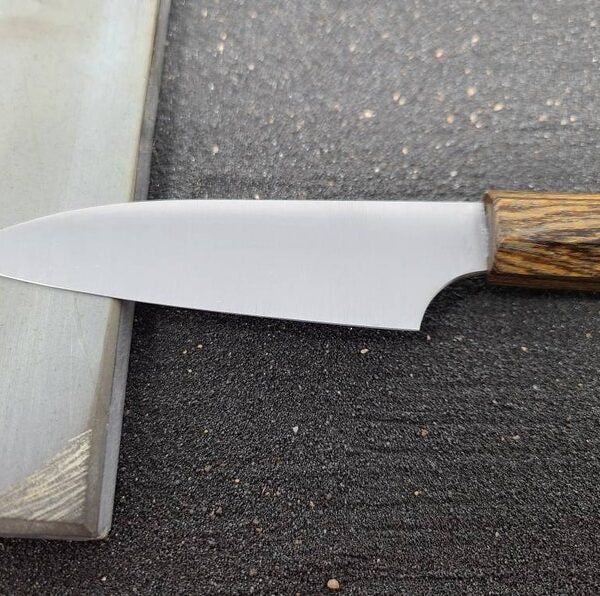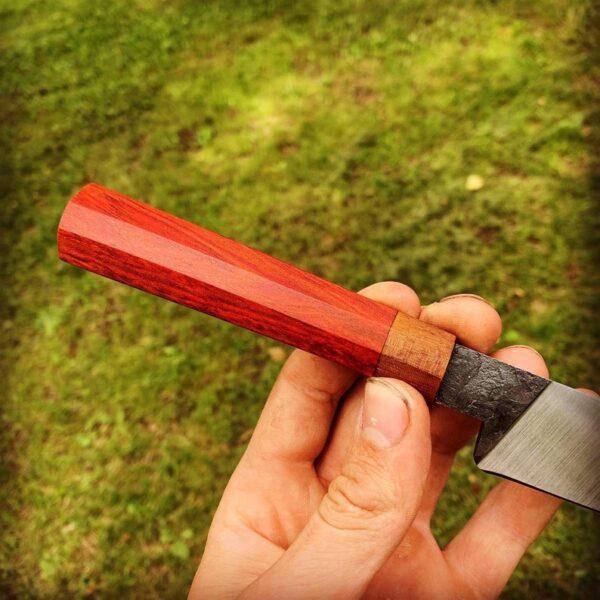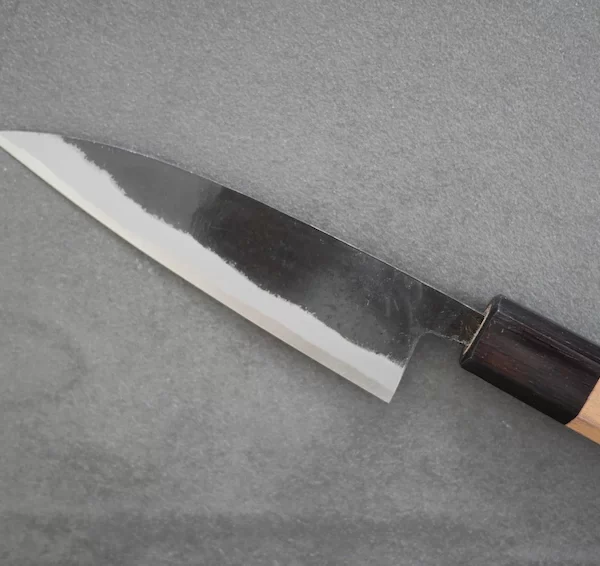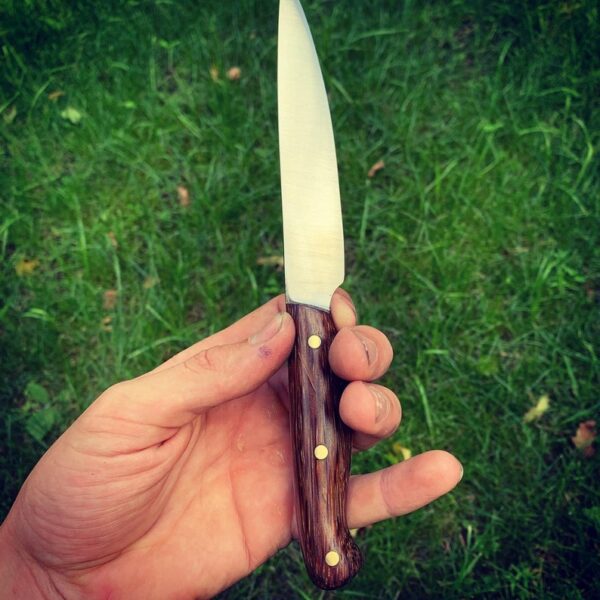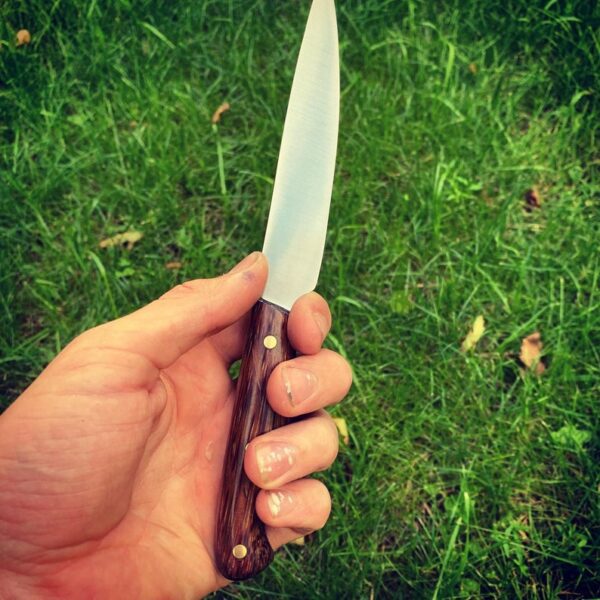Paring Knife
A Paring Knife is an indispensable tool that brings precision and versatility to the kitchen. Its unique structure, featuring a short, narrow blade with a pointed tip, makes it an ideal choice for intricate cutting tasks.
The typical structure of a Paring knife includes a short blade, usually ranging from 2 to 4 inches in length, and a comfortable handle that allows for precise control during intricate cutting tasks. Our Paring knives are available in various styles, including straight-edged and serrated, catering to different culinary preferences and cutting needs.
History Of Paring Knives
The history of this versatile tool dates back several centuries to Europe, where it was originally known as a “peeler knife” or “apple knife.” The first paring knives were likely handmade by blacksmiths, who crafted them from high-carbon steel and fitted them with strong wooden handles. These early knives were simple in design, with a straight, narrow blade and a rounded tip.
As the demand for paring knives grew, manufacturers began mass-producing them using machine-cutting techniques. Paring knives have also become a popular collectible item among knife enthusiasts. Vintage paring knives from the 19th and early 20th centuries are highly sought after for their historical significance and unique designs.
Enhance Your Culinary Skills with Our Paring Knife
Discover a new realm of culinary excellence with our exceptional custom paring knife, designed to elevate your kitchen experience. Packed with unique features, this indispensable tool goes beyond the ordinary, offering precision, versatility, and comfort to help you unleash your creativity in the kitchen.
-
Razor-Sharp Precision
Our paring knife’s slender and pointed blade is designed for precision. Whether you are delicately peeling an apple, deveining shrimp, or creating intricate garnishes, our paring knife allows you to execute these tasks with finesse. Its controlled handling ensures that you can achieve razor-sharp precision, turning ordinary ingredients into culinary works of art.
-
Non-Slip Mastery
Experience confidence in every cut with our paring knife’s non-slip feature. The textured surface of the handle ensures a secure grip, even during intricate maneuvers. This feature not only enhances safety but also allows you to master precision without compromise.
-
Comfort in Every Cut
Crafted with ergonomic designs, our modern handmade paring knives prioritize comfort during use. The handle provides a secure grip, allowing you to focus on the artistry of your cuts without unnecessary strain. This comfort ensures that even extended culinary endeavors become a pleasure rather than a chore.
-
Creative Garnishes
Elevate your culinary presentations by using our paring knife’s ability to create intricate garnishes. Whether it’s crafting decorative twists of citrus peel or delicately carved vegetables, this tool empowers you to add a touch of creativity and sophistication to your dishes.
Which Foods Can You Cut with Our Japanese Paring Knife?
Our versatile handmade custom kitchen paring knife is a culinary companion designed to handle a wide array of foods with precision and ease. Whether you’re a professional chef or a home cook, our knife is adept at cutting various ingredients, making it an indispensable tool in the kitchen. Here are some examples of the foods you can effortlessly cut with our exceptional paring knife:
-
Fruits
Our Japanese paring knife excels in the delicate art of fruit preparation. From peeling apples and pears to segmenting citrus fruits, the precision of this knife ensures clean cuts and minimal waste.
-
Vegetables
When it comes to vegetables, our Japanese paring knife is a versatile companion. Use it to trim and peel vegetables like carrots, potatoes, and cucumbers. The sharp blade enables you to make precise cuts, whether you are creating julienne strips for salads or meticulously removing seeds and cores from bell peppers.
-
Herbs and Greens
Say goodbye to bruised herbs and unevenly chopped greens. Our Japanese paring knife’s precision is ideal for finely chopping herbs like basil, cilantro, and parsley. Its controlled handling allows you to achieve uniform cuts, enhancing the flavors and presentation of your dishes.
-
Small Meats and Poultry
While our Pocket knife may not be the primary tool for butchering, it is also exceptionally useful for small cutting tasks involving meats and poultry. Trim excess fat, remove the skin, or make precise cuts for intricate recipes – our knife’s sharpness ensures a seamless process.
-
Delicate Seafood
The nimbleness of our Japanese paring knife makes it well-suited for delicate seafood preparation. Whether you are deveining shrimp, trimming fish fillets, or peeling shrimp and lobster, the precision and control provided by the knife ensure that your seafood dishes are prepared with finesse.
Bread and Soft Cheese
While not designed for heavy-duty bread slicing, our paring knife is perfect for precision tasks like cutting small rolls, bagels, or soft cheeses. The pointed tip and sharp edge make it easy to handle these items without crushing or tearing.
How Can You Safely Store Your Paring Knife?
Ensuring the safe storage of your Japanese Santoku knife is crucial for maintaining its sharpness and preventing accidents in the kitchen. Proper storage not only protects the blade but also safeguards you and others from potential injuries.
-
Use a Knife Block
Investing in a quality knife block or a magnetic strip is a highly effective and popular method for storing your paring knives safely. Knife blocks offer individual slots for each knife, keeping them separated and reducing the risk of accidental contact. Magnetic strips, when mounted on the wall, provide a space-efficient solution that allows easy access to your paring knife while keeping it visible and securely in place.
-
Drawer Storage
For those who prefer drawer storage, blade guards are indispensable. These protective covers shield the sharp edge of kitchen knives, preventing it from coming into contact with other utensils or your hands when reaching into the drawer. Ensure the blade guard fits securely to guarantee maximum protection and minimize the risk of nicks.




